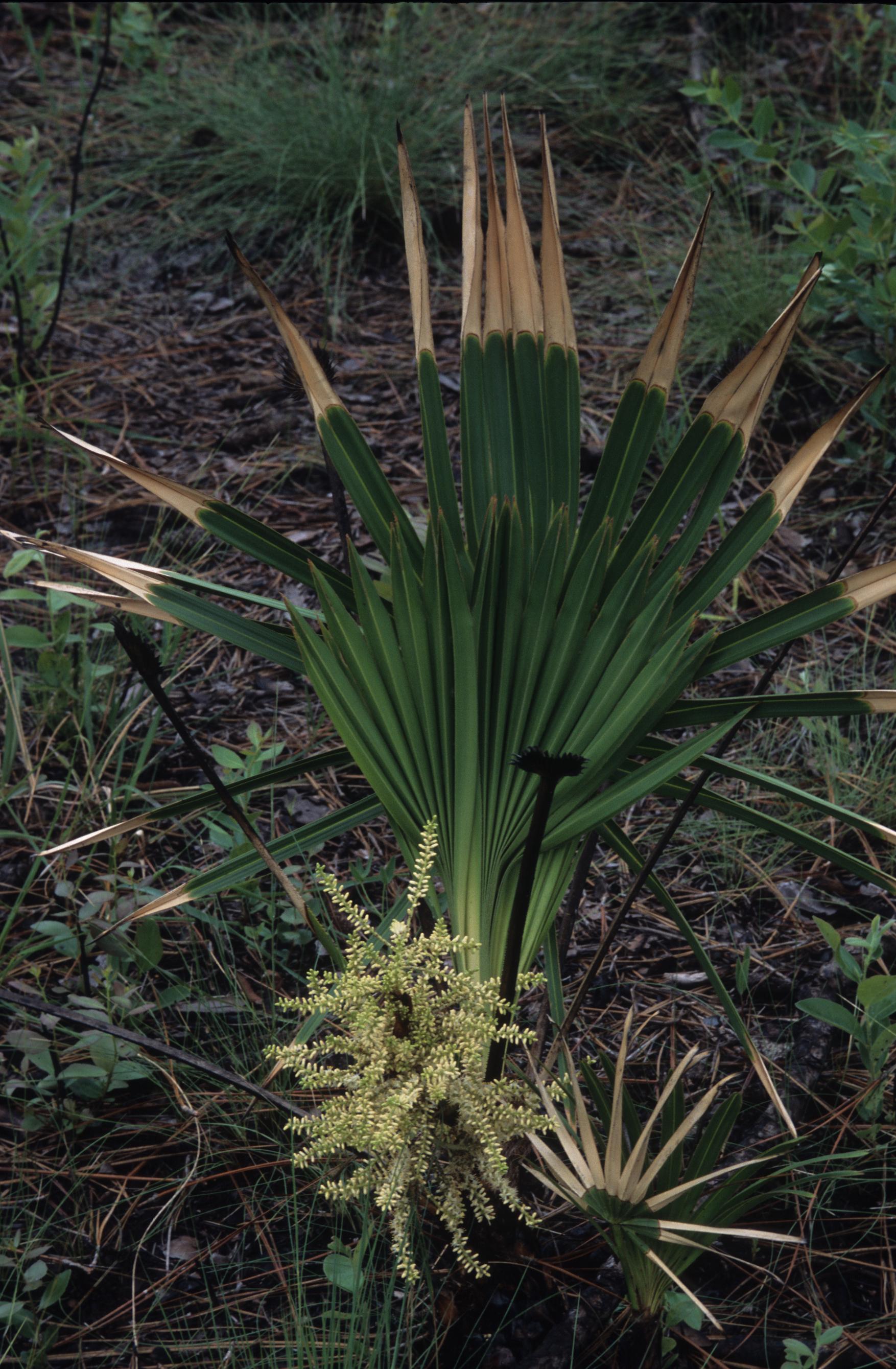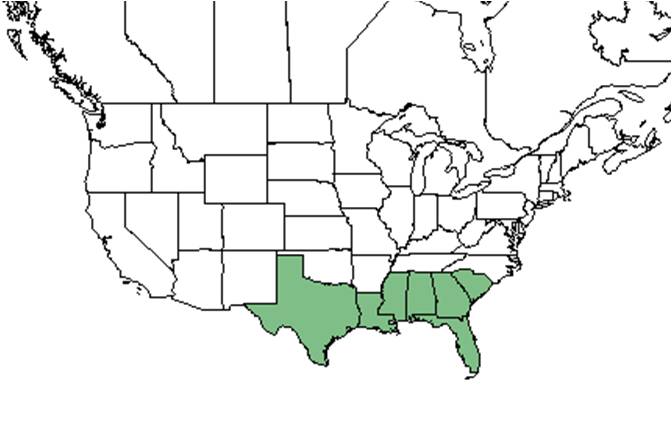Difference between revisions of "Serenoa repens"
KatieMccoy (talk | contribs) (→Description) |
KatieMccoy (talk | contribs) |
||
| Line 33: | Line 33: | ||
==Ecology== | ==Ecology== | ||
===Habitat=== <!--Natural communities, human disturbed habitats, topography, hydrology, soils, light, fire regime requirements for removal of competition, etc.--> | ===Habitat=== <!--Natural communities, human disturbed habitats, topography, hydrology, soils, light, fire regime requirements for removal of competition, etc.--> | ||
| − | In the Coastal Plain in Florida and Georgia, ''Serenoa repens'' has occurred around sinkholes in oolite, on dunes in an understory of ''Pinus clausa'', sandpine-evergreen oak scrubs, cabbage palm-hardwood hammocks, pine flatwoods, open slashpine woodlands, coastal hammocks, ''Baccharis'' flats, longleaf pine-scrub oak ridges, dried up ponds, and pine-oak woodlands. It has been found in disturbed areas such as open pastures, roadsides, and a newly planted slash pine plantation with deep sterile sandy soil ( | + | In the Coastal Plain in Florida and Georgia, ''Serenoa repens'' has occurred around sinkholes in oolite, on dunes in an understory of ''Pinus clausa'', sandpine-evergreen oak scrubs, cabbage palm-hardwood hammocks, pine flatwoods, open slashpine woodlands, coastal hammocks, ''Baccharis'' flats, longleaf pine-scrub oak ridges, dried up ponds, and pine-oak woodlands. It has been found in disturbed areas such as open pastures, roadsides, and a newly planted slash pine plantation with deep sterile sandy soil<ref name="fsu"/>. It will occur on sites ranging from xeric to hydric and on soils ranging from strongly acidic to alkaline<ref name="mcnab">McNab, W. H. and M. B. Edwards (1980). "Climatic Factors Related to the Range of Saw-Palmetto (Serenoa repens (Bartr.) Small)." The American Midland Naturalist 103(1): 204-208</ref> and has been found on sandy loam and sand<ref name="fsu"/>. Associated species include ''Persea, Rapanea, Myrica, Ficus'', and ''Ardisia'' <ref name="fsu"/>. |
===Phenology=== <!--Timing off flowering, fruiting, seed dispersal, and environmental triggers. Cite PanFlora website if appropriate: http://www.gilnelson.com/PanFlora/ --> | ===Phenology=== <!--Timing off flowering, fruiting, seed dispersal, and environmental triggers. Cite PanFlora website if appropriate: http://www.gilnelson.com/PanFlora/ --> | ||
Revision as of 16:58, 15 March 2016
| Serenoa repens | |
|---|---|

| |
| Photo taken by Gil Nelson | |
| Scientific classification | |
| Kingdom: | Plantae |
| Division: | Magnoliophyta - Flowering plants |
| Class: | Liliopsida – Monocotyledons |
| Order: | Arecales |
| Family: | Arecaceae ⁄ Palmae |
| Genus: | Serenoa |
| Species: | S. repens |
| Binomial name | |
| Serenoa repens (W. Bartram) Small | |

| |
| Natural range of Serenoa repens from USDA NRCS Plants Database. | |
Common name: saw palmetto
Contents
Taxonomic notes
The genus Serenoa honors Sereno Watson, an assistant of Asa Gray. Repens refers to the plant's creeping habit[1].
Description
A description of Serenoa repens is provided in The Flora of North America.
S. repens has been observed to have no true stem, with petiole spinescent below surface[2].
Distribution
This species is distributed from South Carolina to southeastern Louisiana[3]. It is one of the most abundant species in Florida[1].
Ecology
Habitat
In the Coastal Plain in Florida and Georgia, Serenoa repens has occurred around sinkholes in oolite, on dunes in an understory of Pinus clausa, sandpine-evergreen oak scrubs, cabbage palm-hardwood hammocks, pine flatwoods, open slashpine woodlands, coastal hammocks, Baccharis flats, longleaf pine-scrub oak ridges, dried up ponds, and pine-oak woodlands. It has been found in disturbed areas such as open pastures, roadsides, and a newly planted slash pine plantation with deep sterile sandy soil[2]. It will occur on sites ranging from xeric to hydric and on soils ranging from strongly acidic to alkaline[4] and has been found on sandy loam and sand[2]. Associated species include Persea, Rapanea, Myrica, Ficus, and Ardisia [2].
Phenology
It has been observed flowering March through June and fruiting April through December (FSU Herbarium).
Seed dispersal
Seed bank and germination
Fire ecology
S. repens has been observed growing in burned turkey-oak pinewoods and recently burned longleaf pine-turkey oak sandhill (FSU Herbarium).
Pollination
The following Hymenoptera families and species were observed visiting flowers of Serenoa repens at Archbold Biological Station (Deyrup 2015):
Apidae: Apis mellifera, Bombus impatiens, Epeolus glabratus, E. pusillus, E. zonatus,
Colletidae: Colletes banksi, C. brimleyi, C. mandibularis, C. nudus, C. sp. A, Hylaeus graenicheri
Halictidae: Agapostemon splendens, Augochlora pura, Augochlorella aurata, Augochloropsis metallica, Halictus poeyi, Lasioglossum miniatulus, L. nymphalis, L. placidensis, L. puteulanum, Sphecodes heraclei
Leucospididae: Leucospis affinis, L. birkmani, L. robertsoni, L. slossonae
Megachilidae: Megachile xylocopoides
Pompilidae: Episyron conterminus posterus, Tachypompilus f. ferrugineus
Sphecidae: Bicyrtes quadrifasciata, Cerceris blakei, C. flavofasciata floridensis, C. fumipennis, C. rozeni, C. rufopicta, Crabro hilaris rufibasis, Ectemnius decemmaculatus tequesta, E. maculosus, E. rufipes ais, Isodontia exornata, I. mexicana, Larra bicolor, Liris beata, L. muesebecki, Oxybelus decorosum, O. laetus fulvipes, Pseudoplisus phaleratus, Sceliphron caementarium, Stictiella serrata, Tachysphex apicalis, T. similis, Tachytes distinctus, T. guatemalensis, T. mergus, Tanyoprymnus moneduloides, Xysma ceanothae
Vespidae: Eumenes smithii, Euodynerus apopkensis, Mischocyttarus cubensis, Monobia quadridens, Pachodynerus erynnis, Parancistrocerus bicornis, P. salcularis rufulus, Polistes bellicosus, P. metricus, Stenodynerus beameri, S. lineatifrons, Vespula squamosa, Zethus slossonae, Z. spinipes
Use by animals
Diseases and parasites
Conservation and Management
Cultivation and restoration
Photo Gallery
References and notes
Deyrup, M.A. and N.D. 2015. Database of observations of Hymenoptera visitations to flowers of plants on Archbold Biological Station, Florida, USA.
Florida State University Robert K. Godfrey Herbarium database. URL: http://herbarium.bio.fsu.edu. Last accessed: November 2015. Collectors: Loran C. Anderson, L. Baltzell, Walter M. Buswell, Angus Gholson, J.P. Gillespie, Robert K. Godfrey, Bruce Hansen, JoAnn Hansen, R.D. Houk, Lisa Keppner, Robert Kral, O. Lakela, S.W. Leonard, Sidney McDaniel, Richard S. Mitchell, Chas. A. Mosier, Gwynn W. Ramsey, John K. Small, Alfred Traverse, H.R. Totten, David E. Wilson. States and Counties: Florida: Calhoun, Clay, Dade, Escambia, Franklin, Gadsden, Gulf, Hernando, Jackson, Lake, Leon, Levy, Liberty, Madison, Monroe, Orange, Palm Beach, Taylor, Washington. Georgia: Thomas. Compiled by Tall Timbers Research Station and Land Conservancy.
- ↑ 1.0 1.1 Bennett, B. C. and R. H. Judith (1998). "Uses of Saw Palmetto (Serenoa repens, Arecaceae) in Florida." Economic Botany 52(4): 381-393
- ↑ 2.0 2.1 2.2 2.3 Florida State University Robert K. Godfrey Herbarium database. URL: http://herbarium.bio.fsu.edu. Last accessed: November 2015. Collectors: Loran C. Anderson, L. Baltzell, Walter M. Buswell, Angus Gholson, J.P. Gillespie, Robert K. Godfrey, Bruce Hansen, JoAnn Hansen, R.D. Houk, Lisa Keppner, Robert Kral, O. Lakela, S.W. Leonard, Sidney McDaniel, Richard S. Mitchell, Chas. A. Mosier, Gwynn W. Ramsey, John K. Small, Alfred Traverse, H.R. Totten, David E. Wilson. States and Counties: Florida: Calhoun, Clay, Dade, Escambia, Franklin, Gadsden, Gulf, Hernando, Jackson, Lake, Leon, Levy, Liberty, Madison, Monroe, Orange, Palm Beach, Taylor, Washington. Georgia: Thomas. Compiled by Tall Timbers Research Station and Land Conservancy.
- ↑ [[1]]Floridata. Accessed: March 15, 2016
- ↑ McNab, W. H. and M. B. Edwards (1980). "Climatic Factors Related to the Range of Saw-Palmetto (Serenoa repens (Bartr.) Small)." The American Midland Naturalist 103(1): 204-208